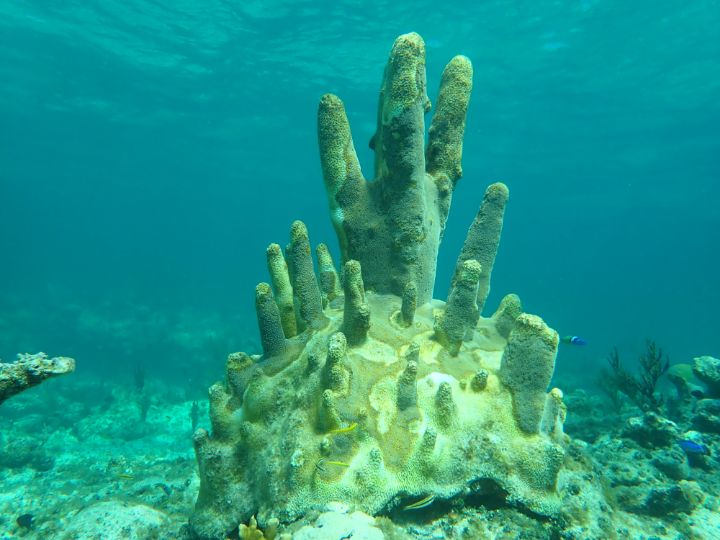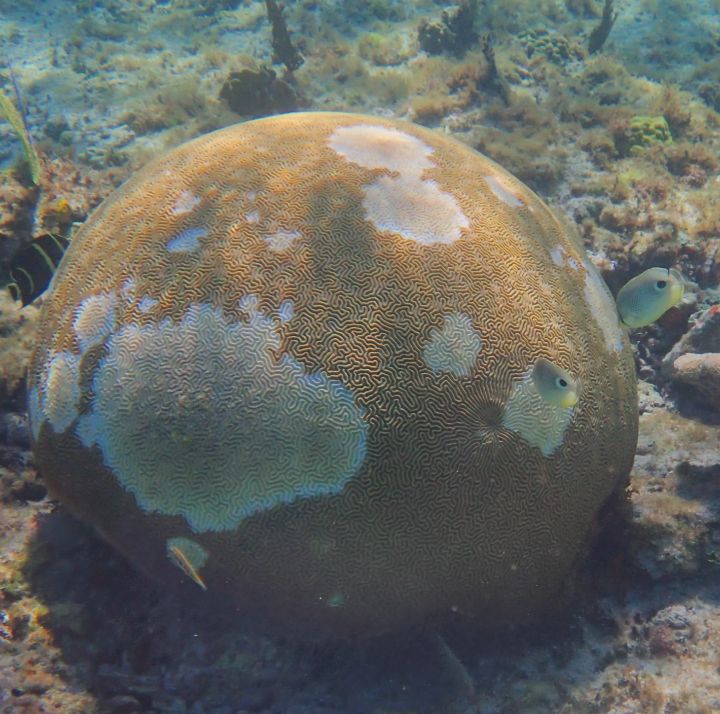|

|
 |
|
Last Updated: Apr 8, 2020 - 8:19:08 AM |

Stony Coral Tissue Loss Disease (SCTLD), a new coral disease outbreak, poses the single greatest threat to roughly half the coral species in The Bahamas. The disease has spread over vast areas of shallow reefs in Grand Bahama.
Photo courtesy of the Perry Institute for Marine Science
|
Cruise, commercial ships linked to spread
A new, rapidly spreading outbreak of Stony Coral Tissue Loss Disease (SCTLD) has quietly infiltrated nearly 40 miles of Grand Bahama’s southern coastline, killing a wide range of coral including some that are already endangered.
“Corals are the engineers that build the entire marine ecosystem. Without them the ecosystem collapses. The reefs lose their function. It makes a fundamental change in the ecosystem from what we’ve seen in the past,” said Dr Craig Dahlgren, a marine ecologist with the Perry Institute for Marine Science (PIMS) who led the research investigation last month.
”The greatest infection rates and greatest amount of mortality were close to Freeport, close to the port. For some species, 90 percent of the corals were either dead or dying. It was very widespread at that point. In those severe cases, there is little you can do to help those corals.”
Silent and deadly, if the outbreak goes unchecked scientists believe the fallout could prove worse than the 1930s marine disease which wiped out sponging beds across the country and led to the crash of the Bahama Islands then number one industry, sponging.

A report authored by the Perry Institute of Marine Science linked the introduction of the underwater outbreak to cruise ships and large commercial vessels. A government-led taskforce is expected to be created in short order to address this dire threat to The Bahamas’ marine ecosystem. Photo courtesy of the Perry Institute for Marine Science
|
Although corals typically face a number of threats, including nearly a dozen different diseases, SCTLD poses the single greatest hazard since roughly half of the coral species in the Bahamas are susceptible. Other diseases usually infect maybe two to three species. SCTLD is also more lethal and spreads faster.
The report for Grand Bahama submitted to government agencies on March 16, linked the introduction of the disease to The Bahamas with cruise ships and large commercial vessels.
“It is more likely that SCTLD reached Grand Bahama through vessel traffic into and out of Freeport. Most likely ballast water from large commercial vessels (cruise ships or cargo ships) coming from Miami or another infected area are the culprit and may present the greatest threat to spread of the disease,” the report read.
“Since its introduction, however, the disease has spread over vast areas on shallow reefs, probably due to alongshore currents.”
The ballast water ships carry for stability can contain thousands of aquatic or marine microbes, plants and animals, which then gets transported across their route. Untreated ballast water released at the ship’s destination could potentially introduce a new invasive marine species.
According to the International Maritime Organization (IMO) hundreds of such invasions have already taken place, sometimes with devastating consequences for the local ecosystem.
Had the waterborne disease been reported sooner, scientist, marine biologists and environmental protection agencies could have done a better job of removal and containment, potentially saving more reefs around Grand Bahama.
At least one dive shop claimed to have seen impacted coral as early as July 2019. However, it wasn’t until late December and January of this year that information began trickling into the relevant authorities.
Back in October, PIMS, the non-profit organization committed to protecting oceans through timely research, conducted reef surveys to assess the impact of Hurricane Dorian to the marine environment.
Scientists surmise only a very tiny percentage of corals in Grand Bahama had likely been touched by SCTLD at that time, since no signs of the disease was visible on the reefs surveyed. However, no surveys were conducted near the port area.
Dorian may have played a role in transporting the disease through water movement, advancing SCTLD progression to corals already weakened by storm-related stress.
“We are already behind. We need to act now,” said Dr Dahlgren, an internationally recognized expert in a wide range of areas related to tropical marine ecosystems.
Over four days, from March 12-15, a team of researchers conducted rapid assessment of 25 Grand Bahama reefs. That number included 18 shallow reefs spread between High Rock in the east and Bootle Bay in the west, one site in Lucayan National Park and one in Peterson Cay National Park.
Seven deeper reefs were also assessed – one in Lucayan National Park, two between Lucayan National Park and Peterson Cay National Park, and four sites between the Grand Bahama Waterway and the entrance to Bell Channel.
“The highest concentration of dying and dead corals appeared to be around the port. That’s why I think that transmission in ballast water from shipping, whether it’s Florida or some other place which has the disease already, is the likely culprit of why it got there, versus if it came in on ocean currents. We would have seen a very different pattern if that had happened,” said Dr Dahlgren.
“When we were out conducting our surveys in mid-March just a couple of weeks ago, there were boats right off the port that were dumping hundreds of gallons of water out. I don’t know what that water was.”
The data suggests the disease may have already spread across shallow reefs of the entire south coast of Grand Bahama from West End to McLean’s Town.
“At this point it’s too late to save many of those reefs but we can work on containing it so it doesn’t spread further along the coast of Grand Bahama or make a jump from Grand Bahama to Abaco or to New Providence or the Berry Islands or [see] new infections popping up in other places, transported through other means,” said Dr Dahlgren.
Following the release of its report, PIMS has teamed up with the Bahamas National Trust, Grand Bahama Port Authority, the BEST Commission, the Department of Marine Resources and other concerned parties to formulate strategies and provide working guidelines to the government moving forward.
“Nobody has identified the exact pathogen that’s causing the disease. In Florida and other places, they treat individual corals with antibiotic paste. It appears to be slowing the spread of the disease but it’s very labor intensive, not cost effective and lack the success rate scientists hope for,” said Dr Dahlgren.
“Like Covid 19, the key to success is to prevent transmission, in this case, from one reef to another. In some places where we only saw one or two corals infected, if we were able to get out there with a team we probably could do something to prevent further spread of the disease there but it would require going out monthly or maybe even more frequently to either treat corals or remove infected corals.”
In the meantime, PIMS recommends ships discharge ballast or bilge water where they picked it up or far away from shore to avoid reef contamination. Other preventative measures include treating bilge water to kill all microbes and decontaminating fishing, diving and snorkeling equipment to avoid the spread of SCTLD by humans.
“If fishermen or divers see something, like corals dying off, we need them to say something. We don’t have a formal mechanism in place yet, but they can email PIMS. If we catch SCTLD earlier than we did in Grand Bahama we probably can do something about it,” said the marine ecologist.
“When cruise ships return there are a lot of places that are at risk just because of the amount of international shipping traffic that exist. Now that SCTLD is in The Bahamas, we have to also be careful with mailboats and inter-island travel as well.”
PIMS anticipates a government-led, multi-disciplinary task force will be constituted shortly to address this marine crisis.
Read attached report

© Copyright 2020 by thebahamasweekly.com
Top of Page
|
|
 |

|
